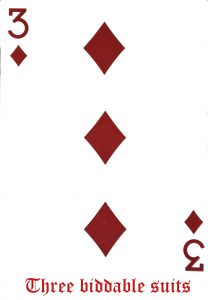The section covers hands with three biddable suits.
[4-4-4] Before opening a hand with three biddable suits bear in mind that you may not get an opportunity for a third call. This is the combination 4-4-4-1, which pops up about 3% of the time.
Your bids need to be as informative to partner as possible. If you find room for three bids all well and good. If not, ask yourself what partner will understand about your hand if you only get to bid twice.
When you hold three biddable suits, bid the one below the singleton unless it is a ♣, in which case bid the ♥. This rule allows the bidding to continue at the lowest possible level. On subsequent calls bid the suits in descending order.
With a singleton ♦ , for example, North would bid as follows:
1♣ 1♠ 2♥
He bids 1♣, the suit below the ♦ singleton, and then the others in descending order—the ♠ first, then the ♥.
If the player has reversing values, then he incorporates this information into the bidding by “reversing” the second and third suits. So the first suit pinpoints the singleton while the subsequent bids reveal 16+ points:
1♣ 1♥ 1♠
Don’t forget that you can only reverse suits that are of equal length; but they do not need to be touching in 3-suited hands.
North as opener
♠ K J 6 3
♥ 5
♦ A J 10 6
♣ A J 4 2
With 14 points North has three biddable suits. He opens with the one below the singleton, bidding 1♦ . Once partners have exchanged a few bids South will work out that the opening bid was below the singleton and that North has only one heart. If they can find a fit there is plenty of room for crossruffing.
With this next hand the ♣ suit is the singleton, so North opens with 1♥. The rule is, with touching suits, open with the middle one. This allows for a possible discovery of a spade fit at the one level.
North
♠ K J 6 3
♥ A J 10 6
♦ A J 4 2
♣ 5
On the other hand if North had only 12 points he would be too weak to open and will No Bid. He must wait to see what South has to say for himself.
Note that you should treat a hand as a standard 4-4 distribution if one of the suits is unbiddable. In the following example the ♠ suit is headed by a lowly 9 and is not biddable:
North
♠9 6 4 2
♥ A Q J 10
♦ 4
♣ A K 10 8
With 14 points this is a perfect suit opener. North opens 1♥ (showing his major first). Then he will show his clubs next time round if given the opportunity.
Summary
- With 13-19 points open one of a suit.
- Your opening bid promises a rebid.
- Opener adds 1 point for each card over four in the biddable suit.
| Choosing the right opening bid | |
|---|---|
| 4-4 5-5 6-6 | Bid the highest suit first, unless the suits are black, in which case bid ♣s first |
| 5-4 6-5 | Bid the longest suit first, unless this suit is weak, in which case bid the short suit if it is higher ranking |
| 6-4 7-5 | Bid and rebid the longest suit (twice). Only mention the shorter suit on the third bid |
| 4-4-4-1 | Open with the suit below the singleton. If ♠s bid the middle of touching suits |
Always remember, length before strength when choosing which suit to bid.
A final word on bidding
Can I have a few words with you? Indeed, there are only 18 words you are allowed to use during the bidding. Serious penalties, even expulsion from the club, awaits anyone who flouts this rule. You can bid “1♣”, but certainly not, “Oh I suppose my only option is to bid 1♣.” Or “I’ll try a dodgy 2♥s.” If you do this, at the very least the game will be folded and a new deal made.
You can say the numbers from one to seven, the four suits and no trumps; pass, no or no bid, double, and redouble, and that’s just about it.
So how do you describe your hand to your partner when there are approximately 635 billion possible combinations? The answer lies in the Acol Bidding System and the use of bidding conventions.
We will get into all this later. But for now I will leave you with a few of rules when you can open the bidding.
Definition
Quick trick. The Quick Trick count tots up the number of potential tricks a given hand should make.
Cardinal rule
Rule No 3 – Never count points for short suits and long suits at the same time.
Rule No 4 – Never open 1NT with an unbalanced hand!
Rule No 5 – With a 4-card major and a 5-card minor, prefer to open the major suit.
By Nigel Benetton – based on the UK Acol Bridge Bidding System
Last updated: Friday, 09 April 2021